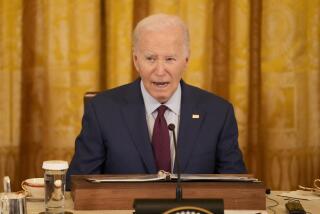The politics of student loans
President Obama set off yet another cacophony of partisan bickering in Washington by warning that interest on some student loans would skyrocket if Congress didn’t act soon. Last week lawmakers from both parties hinted that they were ready to solve the problem, albeit in a temporary and superficial way. But first they ginned up another meaningless political battle, leaving roughly 7 million students in the lurch.
At issue is the interest on subsidized Stafford loans, which the federal government issues directly to low- and moderate-income students. In 2007, Congress cut the interest rate gradually from 6.8% to 3.4%, but only for loans issued before June 30, 2012, after which the rate jumps back to 6.8%.
The rationale for keeping the rate low is stronger today than it was in 2007, considering the alarmingly rapid increase in college tuition. But with student loan debt at historic highs, the availability of cheap loans may be a double-edged sword: It helps families cope with fast-rising college fees, but it encourages students to take on more debt.
It’s worth exploring whether the federal government has enabled colleges to raise tuitions by making loans and grants available to more students, as well as the broader question of how to make college more affordable. There’s precious little time left to do so, however, before the interest rate on Stafford loans is set to jump. Leaders of the House and Senate education committees say they’re pursuing a one-year extension of the lower interest rate to buy time to work out a more comprehensive approach.
The seeming consensus on a temporary fix, however, has given way to sniping over how to cover the $6-billion cost. Senate Democrats first proposed collecting more payroll taxes on high-income workers in small professional services firms; then their House counterparts called for cutting tax breaks for oil and gas drilling. House Republicans, meanwhile, offered a bill, passed Friday on a largely party-line vote, that would eliminate a fund in the 2010 healthcare reform law that finances state and local preventive care projects. It’s doubtful these cuts were chosen for their policy merits. Instead, the goal seems to be making the other side look bad.
That’s how the game is played now in Washington. Even when Democrats and Republicans agree on a destination, they can’t help but pick a fight along the way.
More to Read
A cure for the common opinion
Get thought-provoking perspectives with our weekly newsletter.
You may occasionally receive promotional content from the Los Angeles Times.






